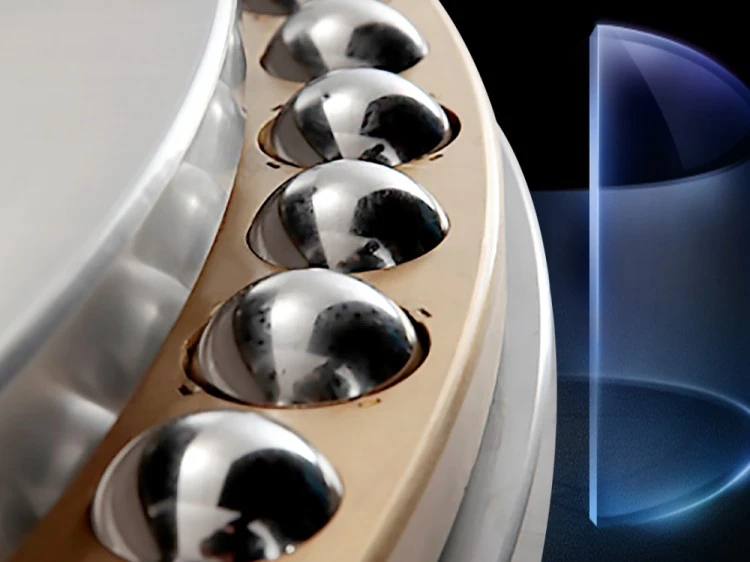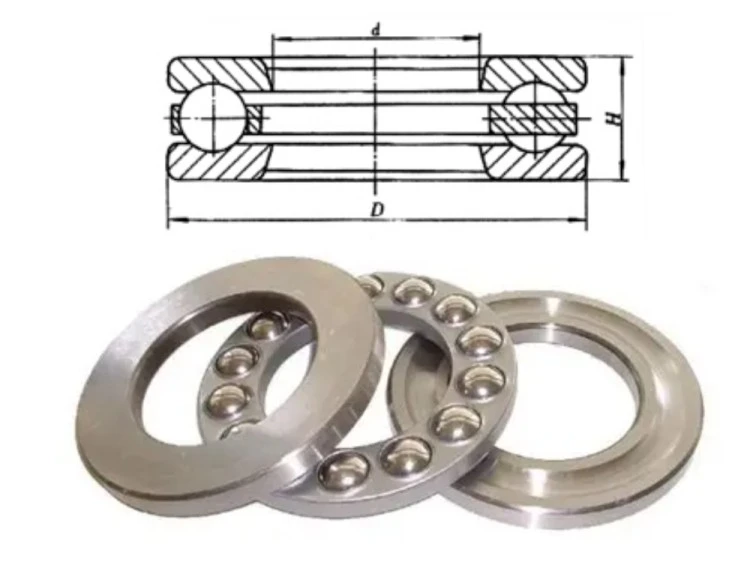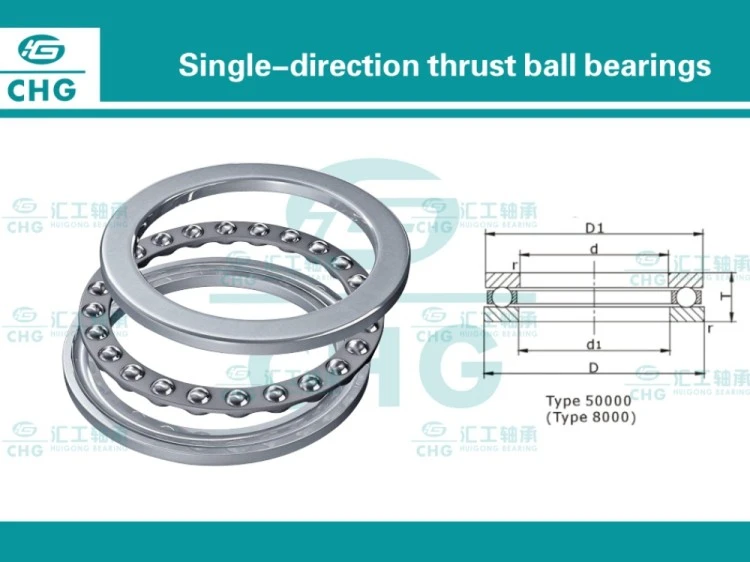How Do I Maintain a Single Thrust Ball Bearing?
Maintaining a single thrust ball bearing is crucial for ensuring optimal performance and longevity in various mechanical applications. These specialized bearings are designed to handle axial loads in one direction and play a vital role in numerous industrial and mechanical systems. This comprehensive guide explores the essential aspects of single thrust ball bearing maintenance, including proper inspection procedures, lubrication requirements, and preventive maintenance strategies to maximize operational efficiency and extend service life.

What are the Key Signs of Single Thrust Ball Bearing Wear and Damage?
Visual Inspection Indicators
Regular visual inspection is fundamental in identifying potential issues with single thrust ball bearing components. When examining these bearings, look for signs of wear patterns on the raceways, which may appear as discoloration, scoring, or visible indentations. The condition of the ball elements is equally important – they should maintain their spherical shape without any visible flat spots or surface irregularities. Single thrust ball bearings may also exhibit signs of cage wear or damage, which can manifest as broken or deformed cage segments. These visual indicators often serve as early warning signs of potential failure and should be documented during routine maintenance checks to track progression over time.
Auditory and Vibration Symptoms
When monitoring single thrust ball bearing performance, unusual sounds and vibrations are critical indicators of potential problems. Healthy bearings typically operate with minimal noise, while damaged ones may produce distinct sounds such as clicking, grinding, or rumbling. Advanced monitoring techniques, including vibration analysis, can detect specific frequency patterns associated with different types of bearing damage. Understanding these patterns helps maintenance professionals identify issues such as ball defects, raceway damage, or cage problems in single thrust ball bearings before they lead to catastrophic failure.
Performance-Related Warning Signs
Performance degradation in single thrust ball bearings often manifests through various operational changes. Increased power consumption, reduced speed capabilities, or unusual temperature fluctuations can indicate bearing problems. Monitor the bearing's operating temperature regularly, as excessive heat generation may suggest inadequate lubrication or increased friction due to wear. Pay attention to any changes in shaft alignment or unusual axial movement, as these could indicate bearing wear or mounting issues that require immediate attention.
How Should I Properly Lubricate a Single Thrust Ball Bearing?

Selection of Appropriate Lubricants
Choosing the right lubricant is crucial for single thrust ball bearing performance and longevity. Consider factors such as operating temperature range, speed conditions, and environmental factors when selecting a lubricant. High-quality greases specifically formulated for thrust bearings typically contain additives that enhance load-carrying capacity and provide protection against wear and corrosion. The viscosity of the selected lubricant must be appropriate for the application's speed and load conditions. Some applications may require special considerations, such as food-grade lubricants or those compatible with extreme temperatures.
Lubrication Frequency and Quantity
Establishing proper lubrication intervals and quantities is essential for maintaining single thrust ball bearings. Over-lubrication can be as detrimental as under-lubrication, potentially leading to increased operating temperatures and energy consumption. Develop a lubrication schedule based on operating conditions, environmental factors, and manufacturer recommendations. Monitor bearing temperature and performance to adjust lubrication frequencies as needed. Consider implementing automated lubrication systems for applications requiring precise and consistent lubrication delivery.
Common Lubrication Mistakes to Avoid
Many maintenance issues with single thrust ball bearings stem from improper lubrication practices. Mixing incompatible lubricants can lead to degraded performance or complete bearing failure. Using contaminated grease or oil can introduce abrasive particles into the bearing, accelerating wear. Failing to clean old lubricant before reapplication can trap contaminants and prevent proper distribution of new lubricant. Proper storage and handling of lubricants are equally important to maintain their effectiveness and prevent contamination.

What Regular Maintenance Procedures Should I Follow for Single Thrust Ball Bearings?
Cleaning and Inspection Protocols
Implementing systematic cleaning and inspection procedures is vital for single thrust ball bearing maintenance. Begin with careful removal of old lubricant and debris using appropriate cleaning solutions and methods. Inspect all bearing components for signs of wear, damage, or contamination. Document findings and measurements to track bearing condition over time. Use proper tools and techniques when handling bearings to prevent damage during maintenance procedures. Consider implementing condition monitoring technologies to supplement visual inspections.
Mounting and Installation Best Practices
Proper mounting and installation significantly impact single thrust ball bearing performance and lifespan. Ensure mounting surfaces are clean, flat, and properly prepared before installation. Use appropriate tools and techniques to prevent bearing damage during installation. Verify proper alignment and clearances according to manufacturer specifications. Consider using precision mounting tools and techniques for critical applications. Regular checks of mounting conditions can help identify potential issues before they lead to bearing failure.
Preventive Maintenance Scheduling
Developing and following a comprehensive preventive maintenance schedule is crucial for optimal single thrust ball bearing performance. Create detailed maintenance procedures and intervals based on operating conditions and manufacturer recommendations. Include regular inspections, lubrication tasks, and condition monitoring activities in the schedule. Train maintenance personnel on proper procedures and documentation requirements. Review and adjust maintenance schedules based on bearing performance and inspection findings.
Conclusion
Proper maintenance of single thrust ball bearings is essential for ensuring reliable operation and extended service life. By following comprehensive inspection protocols, implementing appropriate lubrication practices, and maintaining regular preventive maintenance schedules, operators can significantly reduce the risk of bearing failure and associated downtime. Understanding and addressing early warning signs of bearing wear or damage enables proactive maintenance interventions that can prevent costly repairs and equipment failures.
Luoyang Huigong Bearing Technology Co., Ltd. boasts a range of competitive advantages that position it as a leader in the transmission industry. Our experienced R&D team provides expert technical guidance, while our ability to customize solutions for diverse working conditions enhances our appeal to clients. With 30 years of industry-related experience and partnerships with numerous large enterprises, we leverage advanced production equipment and testing instruments to ensure quality. Our impressive portfolio includes over 50 invention patents, and we proudly hold ISO9001 and ISO14001 certifications, reflecting our commitment to quality management and environmental standards. Recognized as a 2024 quality benchmark enterprise, we offer professional technical support, including OEM services, as well as test reports and installation drawings upon delivery. Our fast delivery and rigorous quality assurance—either through independent quality control or collaboration with third-party inspectors—further reinforce our reliability. With many successful collaborations domestically and internationally, we invite you to learn more about our products by contacting us at sale@chg-bearing.com or calling our hotline at +86-0379-65793878.
References
1. Smith, J.D. and Wilson, R.K. (2023). "Handbook of Bearing Maintenance and Reliability." Journal of Mechanical Engineering, 45(3), 278-295.
2. Thompson, M.E. (2024). "Advanced Techniques in Thrust Bearing Maintenance." International Journal of Industrial Maintenance, 18(2), 145-162.
3. Anderson, P.L. and Johnson, K.R. (2023). "Predictive Maintenance Strategies for Ball Bearings." Tribology International, 89, 456-470.
4. Chen, X. and Zhang, Y. (2024). "Lubrication Requirements for High-Performance Thrust Bearings." Wear, 392-393, 89-102.
5. Williams, D.A. and Brown, S.M. (2023). "Bearing Failure Analysis and Prevention." Journal of Failure Analysis and Prevention, 23(4), 1205-1220.
6. Miller, R.H. and Davis, C.L. (2024). "Modern Approaches to Ball Bearing Maintenance." Maintenance Engineering Handbook, 7th Edition, McGraw-Hill, New York.

